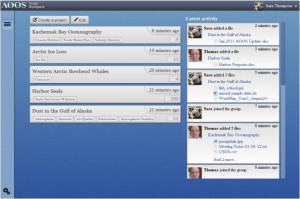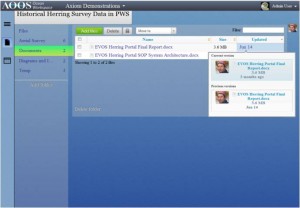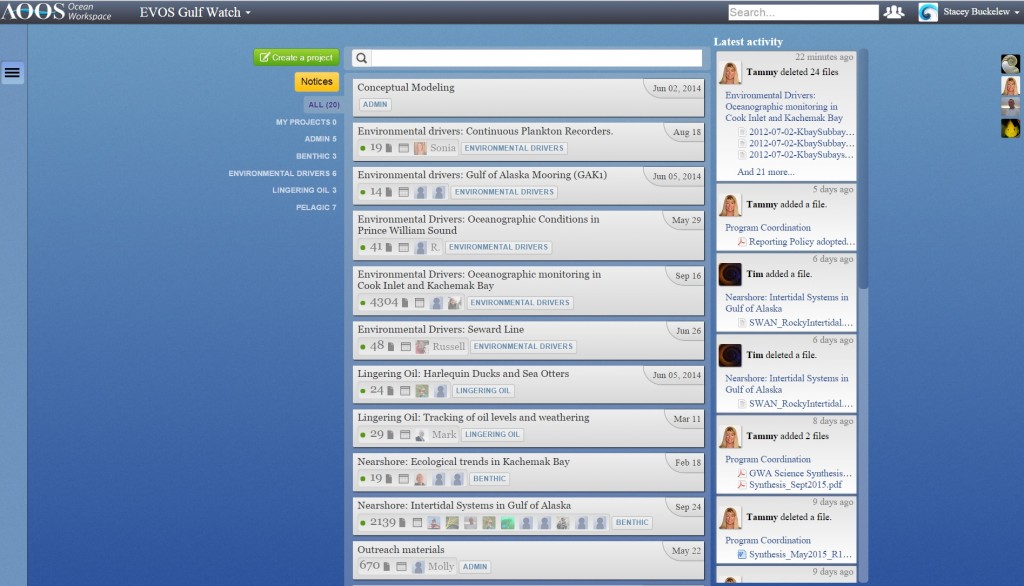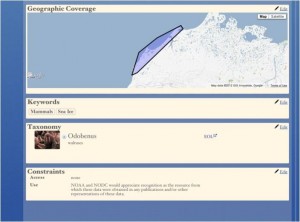Use of the Workspace
- Current users: over 400 individuals
- Number of files uploaded: >100,000
- User Log-in link
- If your program or research group is interested in using the workspace, please contact Rob Bochenek at rob@axiomalaska.com
About the Workspace
The AOOS Research Workspace is a scientific collaboration and data management tool used by researchers and their teams to secure, centralize, and ultimately publish data files on public portals and catalogs. The Workspace offers an intuitive interface that allows users to create projects, which are analogous to scientific studies or efforts. Within each project, users may upload data, descriptive literature, and any other file types by simply dragging and dropping files from their desktop into their web-browser.
How Do You Interact with the Workspace?
Users of the Workspace are organized into groups based on their projects, and everyone within a group can view all of the projects, folders, and files uploaded by other group members. This allows preliminary results and interpretations to be shared among collaborators before the data is shared with the public. Sharing data within the Workspace also provides an opportunity for users to collaboratively organize, analyze, and peer-review their own organizational structure, data, and formats. This platform enables a transparent overview of the progress of data and documentation throughout the lifecycle of the research effort, from raw data to processing and documentation to understandable published data products. The Research Workspace also provides investigators the ability to more effectively work together in teams, meet their data management requirements, and achieve their scientific objectives.
Who is Currently Using the Workspace?
- Alaska Ocean Observing System (AOOS)
- North Pacific Research Board
- Gulf Watch Alaska and the Herring Research and Monitoring Program, two long-term monitoring programs of the Exxon Valdez Oil Spill Trustee Council
- Prince William Sound Science Center
- Chukchi Sea Environmental Studies Program
- Russian-American Long Term Census of the Arctic (RUSALCA)
- Marine Biodiversity Observation Network (mBON)
- NOAA’s Marine and Estuarine Goal Setting for South Florida (MARES)
- Central and Northern California Ocean Observing System (CeNCOOS)
- Southeast Coastal Ocean Observing Regional Association (SECOORA)
…… and many others.
About the Software
The Workspace is a web-based data management system built on open-source software that addresses the need of researchers working together across organizational and disciplinary boundaries. This platform is continuously improved based on analysis of user workflows, and all users and organizations in the Workspace benefit from incremental feature refinements. The Workspace currently has the following capabilities:
- Secure group, user, and project profiles
Users of the Workspace have a password-protected user profile which is associated with one or more disciplinary groups or research programs. Users may navigate between their groups or programs to view and share data. Transfer of data and information occur over Secure Socket Layer (SSL) encryption for all interactions with the Workspace. The Workspace supports Google’s applications authentication system, so if users are already logged into a Google applications account (e.g., Gmail, Google Docs, etc.), they can launch the Workspace without the need to re-authenticate.
- Metadata authoring
The Workspace provides investigators with an integrated metadata editor for generating descriptive metadata for projects using elements shared by the Federal Geographic Data Committee (FGDC) endorsed Biological Profile of the FGDC’s Content Standard for Digital Geospatial Metadata (CSDGM) and the ISO 19115 standards for geospatial metadata. This editor includes tools that allow users to search the ~500,000 taxonomic entities of the Integrated Taxonomic Information System (ITIS) to rapidly generate taxonomic metadata, and to add keywords from NASA’s GCMD list of Science Keywords.
Most importantly, the Workspace is a cloud-based service that is accessed through a web browser, allowing researchers to move between computers during the metadata generation process while still providing team members and administrators the ability to simultaneously review and edit metadata in real-time.
Screen captures of the Workspace metadata editor. The left capture shows the interface to author basic descriptive and citation metadata fields. The right capture displays a tool which allows researchers to define the geographic extent of the project, keywords, document biological species information and capture any data constraints.
- User-friendly, secure file management
The core functionality of the Workspace is the ability to securely manage and share project-level digital resources in real-time with version control. The Workspace functions as a working platform for sharing preliminary data sets and other digital resources among researchers and study teams. Users of the Workspace are provided with tools that allow them to bulk upload files, organize those documents into folders or collections, and organize projects with user-created tags. The Workspace also has the ability to track file versions: if a user re-uploads a file of the same name, the Workspace displays the most current version, but stores and provides access to past versions as well.


Screen captures of project and file management in the Workspace. The left screenshot shows a list of projects to which the example user has access rights. The right screenshot displays the interface a PI would use to organize independent files into collections or folders, and the versioning capabilities of the Workspace: if a file is uploaded with the same name into the same folder, the Workspace tracks the individual versions.



